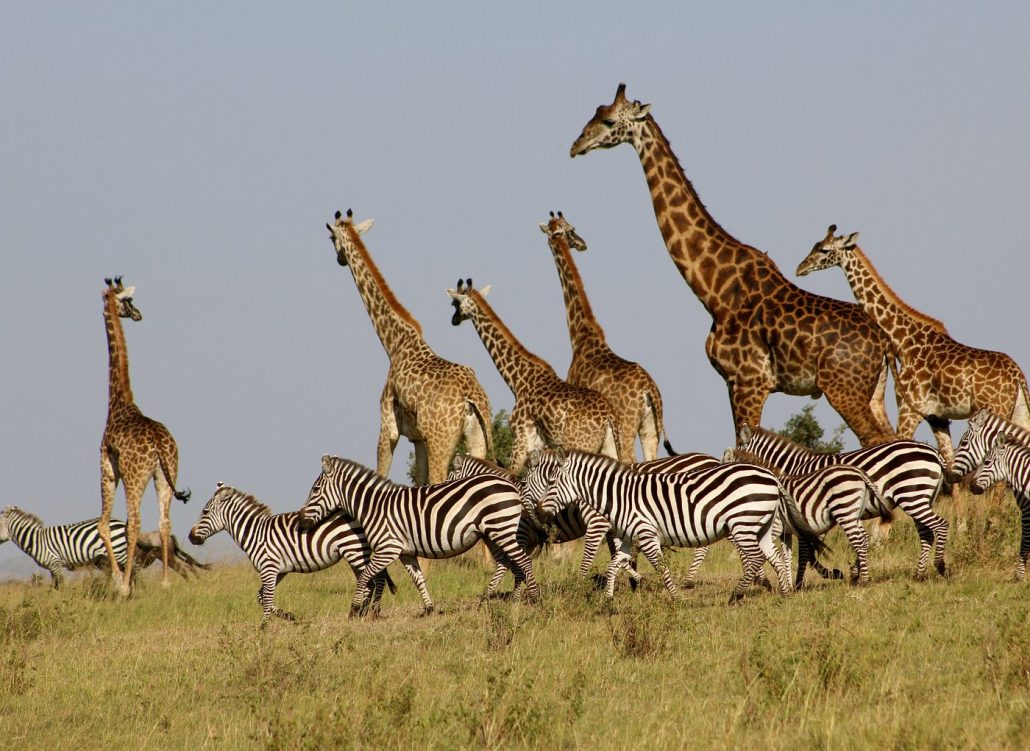Mikumi National Park: A Comprehensive Guide
Mikumi National Park, located in southern-central Tanzania, is the fourth-largest national park in the country, covering an area of approximately 3,230 square kilometers. It is part of the greater Selous ecosystem, sharing its southern border with the massive Selous Game Reserve, one of the largest wildlife reserves in Africa. Established in 1964, Mikumi is often referred to as the “Little Serengeti” due to its expansive floodplains that are reminiscent of the Serengeti, and it is one of Tanzania’s most accessible national parks from the capital, Dar es Salaam, making it a popular destination for both local and international visitors.

Mikumi is bisected by the main A-7 highway, which connects Dar es Salaam to Iringa and the southern highlands. While this road makes the park easily accessible, it also divides the park into two distinct areas: the northern and southern sections. The northern part, which is more developed and frequently visited, contains the park’s main wildlife viewing areas. The southern section is more remote and less visited, providing a more isolated experience of the wilderness.
Attractions in Mikumi National Park
Mikumi National Park offers a quintessential African safari experience, with an abundance of wildlife, bird species, and varied landscapes. Its proximity to Dar es Salaam makes it an ideal option for short safari trips, while its inclusion in the southern circuit offers visitors the chance to combine their visit with nearby parks such as Ruaha National Park and the Selous Game Reserve.
Wildlife In Mikumi National Park
Mikumi National Park is home to a wide variety of wildlife, making it a great destination for game drives and wildlife viewing. The park’s central Mkata Floodplain, with its vast, open savannahs, is the prime area for spotting large herbivores. Commonly seen animals include African elephants, buffalo, zebras, giraffes, and wildebeest. The floodplain also supports smaller antelope species such as impalas, elands, and greater kudus, while the open grasslands make it easier to spot animals compared to more densely vegetated areas.
One of the key attractions in Mikumi is its population of lions, often seen lounging on the termite mounds scattered across the plains. The lions in Mikumi have gained a reputation for occasionally climbing trees, a rare behavior that adds a unique element to the safari experience here. Other predators that call the park home include leopards, hyenas, and jackals, though they are less frequently seen compared to the lions. Cheetahs also inhabit the park, but sightings are relatively rare due to their elusive nature and preference for the less accessible southern areas of the park.
In addition to the larger mammals, Mikumi is home to a variety of smaller animals such as warthogs, baboons, and vervet monkeys. The park’s river systems, including the Mkata River, attract a number of aquatic species, including hippos and crocodiles, which are often spotted lounging in the water or on the riverbanks.
Birding In Mikumi National Park
Mikumi National Park is a birdwatcher’s paradise, boasting over 400 bird species, making it one of the best birding destinations in Tanzania. The park’s diverse habitats, ranging from open plains to riverine forests and wetlands, attract a wide variety of bird species. Whether you are a seasoned ornithologist or a casual bird enthusiast, Mikumi offers plenty of opportunities for birdwatching.
Some of the notable bird species found in the park include the lilac-breasted roller, bateleur eagle, African fish eagle, and the yellow-throated longclaw. The open plains are ideal for spotting large raptors such as martial eagles and brown snake eagles, while the riverbanks attract water birds like herons, storks, and kingfishers. During the wet season, migratory birds flock to the park, adding even more diversity to the birdlife.
For those interested in more rare sightings, the park is also home to the southern ground hornbill and the secretary bird, both of which are impressive and unusual birds often seen striding across the open plains. The wetlands and pools within the park provide excellent opportunities to observe waders and other water-associated birds, including saddle-billed storks, hammerkops, and African jacanas.
Vegetation
Mikumi National Park is characterized by a wide range of vegetation types, which support its diverse wildlife. The most prominent landscape feature is the Mkata Floodplain, an expansive area of flat grasslands that dominate the northern part of the park. These open plains are dotted with termite mounds, acacia trees, and occasional baobabs, creating an iconic African savannah landscape.
In addition to the grasslands, the park contains areas of miombo woodland, which is more prevalent in the southern section. The miombo woodlands are dominated by trees such as brachystegia and julbernardia species, providing a habitat for species such as elephants and giraffes, which feed on the tree leaves. These woodlands also offer shelter to smaller animals and a range of bird species.
Riverine forests line the banks of the park’s rivers and wetlands, providing a contrast to the open plains. These forests are dense and provide shade and water for animals during the dry season, acting as critical wildlife corridors. The vegetation in these areas is lush and green, supporting a different array of plant and animal species. The rivers are fringed with fig trees, wild palms, and tamarinds, creating a beautiful and biodiverse environment.
Scenery Of Mikumi
The scenery in Mikumi National Park is one of its most striking features, with the vast Mkata Floodplain being the main attraction. This area is reminiscent of the Serengeti, with wide-open vistas stretching as far as the eye can see, dotted with the silhouettes of acacia trees and grazing herbivores. During the rainy season, the plains turn green and are often dotted with wildflowers, while in the dry season, the golden grass sways in the wind, creating a classic African savannah landscape.
The park’s backdrop is further enhanced by the surrounding Uluguru and Udzungwa mountain ranges, which can be seen in the distance, creating a stunning horizon that adds depth to the park’s views. The contrast between the flat plains and the towering mountains makes Mikumi a visually diverse park.
The park’s rivers and wetlands also provide picturesque settings, particularly in the early morning or late afternoon when the light is soft and golden. These areas attract a wide range of animals and birds, making them ideal spots for photography and wildlife viewing.
Activities and Main Attractions In Mikumi National Park
Mikumi National Park offers a variety of activities that allow visitors to experience the park’s wildlife and landscapes up close. The most popular activity is a traditional game drive, which takes visitors through the park’s extensive road network, particularly around the Mkata Floodplain, where most of the wildlife is concentrated. Game drives are typically conducted in the early morning or late afternoon when animals are most active, and they offer excellent opportunities to spot the park’s abundant wildlife, including elephants, giraffes, zebras, and lions.
Walking safaris are another exciting way to explore Mikumi, offering a more intimate experience of the park’s flora and fauna. These guided walks allow visitors to learn about the smaller details of the ecosystem, such as animal tracks, plant species, and insects, while also providing a chance to encounter wildlife on foot.
Birdwatching is a key activity for many visitors to Mikumi, with the park’s diverse birdlife offering year-round interest. Birding safaris can be arranged, focusing on the different habitats within the park, from open plains to wetlands and woodlands.
The Hippo Pools are a popular attraction within the park, where visitors can observe hippos and crocodiles in their natural habitat. These pools are located near the Mkata River and are a great spot for photography, especially during the dry season when wildlife congregates around the water.
For those seeking more adventure, Mikumi’s proximity to the Udzungwa Mountains National Park makes it possible to combine a visit to both parks. The Udzungwa Mountains are known for their hiking trails, waterfalls, and unique flora and fauna, offering a contrasting experience to the savannahs of Mikumi.
Best Time to Visit Mikumi National Park
The best time to visit Mikumi National Park is during the dry season, from June to October, when wildlife is more concentrated around water sources, and the weather is more predictable. This period is ideal for game drives, as the open plains make it easier to spot animals, and the roads are generally in good condition.
The wet season, from November to May, can also be a rewarding time to visit, particularly for birdwatchers, as migratory birds arrive in the park. However, visitors should be prepared for occasional heavy rains and the possibility of limited access to certain areas of the park.
Weather and Climate
Mikumi National Park experiences a tropical climate, with distinct wet and dry seasons. The wet season runs from November to May, with the heaviest rainfall occurring between March and May. During this period, the park’s vegetation flourishes, and the landscapes turn green, making it a beautiful time to visit. However, the heavy rains can make some roads impassable, particularly in the more remote areas of the park.
The dry season, from June to October, is the best time for wildlife viewing, as the animals tend to congregate around the remaining water sources, making them easier to spot. The dry season is characterized by warm days and cooler nights, with temperatures ranging from 25°C to 30°C (77°F to 86°F) during the day and dropping to around 15°C (59°F) at night.
Mikumi National Park Rules
To ensure the protection of Mikumi National Park and its wildlife, there are several important rules that visitors must follow:
- Respect Wildlife: Maintain a safe distance from animals at all times. Do not attempt to feed or interact with wildlife, as this can disrupt their natural behaviors and pose risks to both visitors and animals.
- Stay on Designated Roads and Trails: Off-road driving is strictly prohibited to prevent damage to the park’s delicate ecosystems. Visitors should remain on designated game drive routes and walking trails.
- Observe Speed Limits: The speed limit within the park is set to ensure the safety of both wildlife and visitors. Driving too fast increases the risk of accidents with animals.
- Leave No Trace: Visitors are expected to take all their trash with them when leaving the park. Littering can harm wildlife and degrade the natural environment.
- No Disturbing Noise: Loud noises can disturb wildlife and other visitors. Keep noise levels to a minimum to enhance the safari experience for everyone.
- Respect Park Staff and Guidelines: Follow the instructions of park rangers and guides, as they are there to ensure the safety and enjoyment of all visitors.
